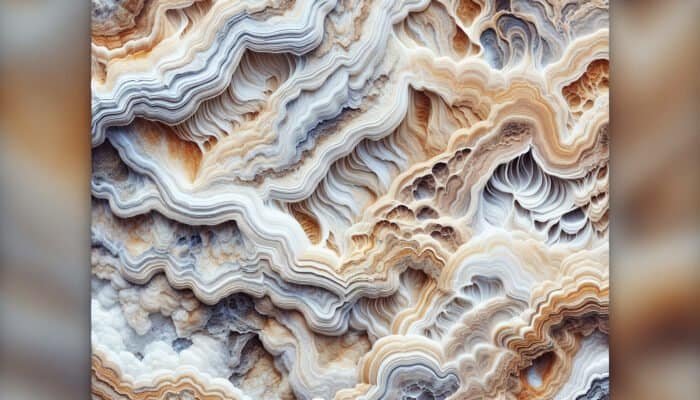Summary of Discover the Most Effective Fillers for Repairing Travertine Holes:
- Travertine is a naturally occurring, porous limestone renowned for its warm shades and distinctive texture, frequently used in homes across the UK for various applications such as flooring, patios, and wall installations.
- Natural voids and holes in travertine can deteriorate over time due to factors like moisture, heavy foot traffic, and changes in temperature.
- Prompt repairs enhance visual appeal and prevent further damage, safeguarding against water infiltration, staining, and structural complications.
- Epoxy-based fillers offer durability and moisture resistance, making them suitable for kitchens, bathrooms, and significant repair jobs. They can be colour-matched for a seamless appearance but necessitate careful application.
- Polyester resin fillers are user-friendly and cure quickly, making them ideal for DIY enthusiasts and minor interior repairs. However, they are less effective in damp or outdoor conditions.
- Selecting the appropriate filler is crucial for both aesthetic enhancement and long-term durability, particularly in high-traffic or moisture-prone areas.
Understanding the Appeal and Maintenance Challenges of Travertine Stone: A Comprehensive Guide
<a href="https://limitsofstrategy.com/essential-guide-to-travertine-floor-sealing/">Travertine</a> is a stunning natural stone that brings warmth and character to any residence. Its unique texture and rich colour variations stem from mineral deposits formed by hot springs over thousands of years, resulting in each slab being distinctly beautiful. This organic allure has made travertine a preferred choice in the UK for flooring, patios, and countertops. However, like all natural materials, maintaining its pristine condition can be a challenge, particularly as it begins to exhibit signs of wear.
A substantial aspect of travertine’s charm lies in its natural structure, which often features small holes and voids created during the geological formation of the stone. These slight imperfections can become more pronounced over time due to regular use, moisture exposure, or even minor shifts in the stone itself. In busy households, especially in high-traffic areas, these holes can expand, compromising both the aesthetic appeal and structural integrity of the surface.
Addressing these holes is vital for preserving travertine. This not only helps restore the stone’s smooth, elegant finish but also rejuvenates its natural beauty. Moreover, sealing these gaps is essential in preventing water infiltration, which can lead to more severe damage. Repairing these voids ensures that the stone maintains its resilience, capable of withstanding daily activities and the unpredictable weather patterns typically encountered in the UK.
Examining the Distinct Features of Travertine as a Natural Stone

Travertine is a naturally beautiful stone, highly valued for its character and earthy aesthetics. Formed from minerals precipitating from hot spring water, this limestone-based material develops a distinctive texture filled with tiny pockets. Its warm hues vary from soft creams to deep browns, making it a popular choice for both indoor and outdoor applications.
Throughout the UK, travertine is commonly used for flooring, patios, and wall features. Its capacity to retain heat makes it an excellent option for underfloor heating systems, enhancing comfort in colder months. However, its porous nature can also make it vulnerable to damage. If subjected to harsh cleaning agents or abrasive tools, it may become stained or damaged. Regular maintenance and sealing are imperative to preserve its appearance and prolong its lifespan.
Identifying the Causes of Holes in Travertine Stone
The natural beauty of travertine includes small holes and voids that originate during its geological formation. Over time, these imperfections can become increasingly noticeable, particularly with exposure to moisture, frequent foot traffic, and varying temperatures. In heavily used areas, what begins as a minor flaw can escalate into a more significant concern.
In the damp UK climate, rainwater can infiltrate these holes, causing expansion or contraction as temperatures fluctuate. This exerts pressure on the stone, making outdoor areas especially susceptible to damage, where heavy furniture or weather exposure can result in cracking and chipping. Vigilantly monitoring these surfaces is crucial for spotting and resolving potential issues early.
The Importance of Repairing Holes in Travertine for Longevity
Repairing the holes in your travertine is not merely a cosmetic concern. It is essential for maintaining the stone’s structural integrity and preventing further degradation. Ignored holes can trap dirt and moisture, leading to staining or weakening of the surface, which ultimately could result in cracks or crumbling of the stone.
By choosing suitable fillers and addressing repairs without delay, you can preserve both the beauty and resilience of your travertine. This small investment is vital in ensuring your stone remains vibrant and functional, whether in indoor or outdoor settings.
High-Quality Fillers for Efficiently Repairing Travertine Holes in the UK

Selecting the right filler for repairing travertine holes can significantly impact the durability and effectiveness of your repairs. Throughout the UK, a wide array of fillers is available, each offering unique benefits. Understanding these distinctions will empower you to choose the most suitable option for your home and the specific circumstances you face.
Epoxy-Based Fillers: Reliable and Long-Lasting Repair Solutions
Epoxy fillers represent a strong and dependable option for fixing holes in travertine. Typically available as a two-part mixture, they cure into a robust bond, making them ideal for enduring wear and tear. Homeowners often select epoxy when addressing larger holes or cracks, as it results in a clean, smooth finish that effortlessly integrates with the surrounding stone.
A key advantage of epoxy lies in its resistance to moisture and cleaning agents, making it perfect for kitchens, bathrooms, and any area prone to spills. Additionally, it can be colour-matched to your travertine, ensuring that the repair remains discreet and visually appealing.
However, precise application of epoxy is crucial for achieving the best results. The surface must be thoroughly cleaned and prepared to ensure optimal adhesion. It is essential to follow the manufacturer’s instructions to achieve a strong and lasting repair.
Polyester Resin Fillers: Convenient and User-Friendly Solutions for Repairs
For those seeking a more accessible option, polyester resin fillers are an excellent choice. They set quickly and are easy to apply, making them perfect for minor repairs. Many DIY enthusiasts in the UK prefer them due to their versatility and rapid curing time. Once set, you can sand the filler to achieve a smooth, even finish.
Another advantage of polyester fillers is their tinting capability, allowing you to match the colour to your stone and maintain a cohesive appearance. This quality makes them ideal for minor chips or moderate damage around the home.
It’s worth noting that these fillers may not perform as well in wet environments. They tend to be less moisture-resistant than epoxy, making them unsuitable for bathrooms or outdoor applications. However, for dry, indoor areas, polyester resin provides a straightforward and appealing solution.
Cement-Based Fillers: Affordable and Easily Accessible Options

Cement-based fillers are among the most cost-effective solutions for addressing travertine holes, making them a popular choice for budget-conscious homeowners across the UK. These fillers are readily available at local hardware stores and can be used to repair both small and larger voids. Their accessibility and low cost make them an appealing option for many.
While cement fillers provide a sturdy repair solution, they may lack the flexibility found in other filler types. This rigidity can create challenges in areas where movement is expected, potentially leading to future cracking at the repair site. Nevertheless, when applied correctly, cement fillers can yield a durable and long-lasting fix.
Homeowners should also consider that cement-based fillers may require additional sealing to enhance their water resistance, particularly for outdoor applications. Regular maintenance, including resealing, is crucial to extend the life of the repairs and prevent future complications. The ease of sourcing cement fillers from local stores enables homeowners to promptly address issues as they arise, avoiding lengthy delivery times.
Acrylic Fillers: Versatile Solutions for Outdoor Applications
Acrylic fillers are a flexible option for repairing travertine holes, particularly in outdoor settings. Known for their adaptability and resilience against weathering, acrylic fillers are well-suited for the UK’s variable climate. These fillers can expand and contract with temperature changes, making them ideal for outdoor patios and driveways where movement is likely.
Another notable benefit of acrylic fillers is their extensive range of colours and finishes, enabling homeowners to achieve a seamless match with their travertine. This feature is particularly appealing to those who value the aesthetic integrity of their surfaces. The application process for acrylic fillers is straightforward, typically requiring only a putty knife for smoothing and shaping the material.
However, while acrylic fillers offer substantial advantages, some users may find them less durable than epoxy-based alternatives, especially in high-traffic areas. Therefore, careful consideration should be given to the specific location of the repair. Overall, acrylic fillers provide a practical and effective solution where flexibility and ease of application are essential.
Silicone-Based Fillers: Optimal for Humid Environments
Silicone-based fillers are acknowledged for their excellent adhesion and flexibility, making them ideal for filling travertine holes in moist environments such as bathrooms and kitchens. These fillers create a watertight seal, preventing moisture from penetrating the stone and causing further damage. For homeowners in the UK, this feature is particularly advantageous in regions prone to high humidity.
A key benefit of silicone fillers is their capacity to withstand temperature fluctuations without losing their performance. This resilience makes them suitable for both interior and exterior applications. Additionally, silicone fillers come in various colours, allowing them to blend seamlessly with the surrounding travertine.
Nevertheless, silicone fillers are generally not recommended for high-load areas due to their softer composition compared to other fillers. Homeowners should carefully assess where they plan to use silicone fillers to ensure they are applied in appropriate locations for optimal results. For instance, they may work exceptionally well in sealing gaps around sinks or bathtubs rather than on heavily trafficked flooring.
Finding Quality Travertine Fillers in the UK: Your Complete Guide
Locating the ideal travertine filler in the UK is crucial for effective repairs. Fortunately, a variety of purchasing options are available, ranging from local hardware stores to online retailers, ensuring that homeowners can find the perfect solution for their needs.
Your Local Hardware Stores: Convenient Sources for Repair Materials
Many local hardware stores across the UK offer a selection of travertine fillers, providing a convenient option for those in need of quick repairs. These stores typically stock reputable brands and feature knowledgeable staff who can assist customers in selecting the right product for their specific needs.
A visit to a nearby hardware store allows homeowners to physically evaluate the fillers, ensuring they choose a colour and consistency that matches their travertine. Additionally, many stores offer smaller quantities, making it easier for DIY enthusiasts to purchase only what they need for specific repairs without the obligation to buy larger, more expensive containers.
Local hardware stores often provide community-focused advice on home repairs, including recommendations on the best fillers and methods for achieving optimal results. This personalised guidance can be invaluable, especially for novice DIYers who may feel overwhelmed by the plethora of products available.
Online Retailers: Benefit from a Wide Selection and Convenience
For those who prefer the comfort of shopping from home, online retailers offer an extensive range of travertine fillers, often accompanied by customer reviews and ratings to assist in making informed purchasing decisions. Websites such as Amazon, eBay, and specialised home improvement platforms allow users to compare various products, prices, and brands, ensuring access to competitive pricing options.
The online shopping experience presents distinct advantages, including the ability to read detailed product descriptions and access expert reviews from other customers who have used the products. This information can help shoppers select fillers best suited to their specific repair requirements.
Additionally, many online retailers provide rapid delivery options, allowing homeowners to receive their chosen products promptly. However, it is crucial to verify the return policies and ensure that the products are suitable before finalising a purchase, as not all online listings guarantee quality.
Specialty Stone Suppliers: Premium Products and Expert Guidance
For those seeking specialised advice alongside their travertine fillers, specialty stone suppliers in the UK offer an attractive option. These suppliers often curate a selection of high-quality fillers specifically designed for use with natural stone, ensuring compatibility and optimal performance.
Beyond merely providing products, specialty suppliers typically employ knowledgeable staff who can offer tailored recommendations based on the specific type of travertine and the extent of the required repairs. This expertise can be particularly beneficial for homeowners undertaking larger projects or those seeking additional guidance on maintenance practices.
Moreover, many specialty suppliers provide supplementary services, such as consultations for more extensive renovations or repairs. This can be invaluable for anyone looking to restore or upgrade their travertine surfaces, as well as for those aiming to ensure the longevity and proper care of their investment.
Assessing DIY Repairs Versus Professional Help for Travertine in the UK
Determining whether to undertake DIY repairs or enlist a professional for travertine holes can present a complex decision for homeowners in the UK. Each option offers its own advantages and considerations, making it essential to assess the specific situation and desired outcomes.
The Advantages of DIY Repairs: Cost-Effective and Fulfilling
Engaging in DIY repairs can be immensely gratifying, providing homeowners with a sense of accomplishment and pride in their work. For those who relish hands-on projects, mending travertine holes can be a rewarding task. Furthermore, opting for a DIY approach can lead to significant cost savings, as homeowners can avoid the labour fees associated with professional services.
Many DIY enthusiasts utilise online resources, such as video tutorials and step-by-step guides, to ensure successful repairs. Equipped with the right information, tools, and materials, individuals can often achieve results that rival professional craftsmanship.
Additionally, DIY repairs grant homeowners complete control over the process, allowing them to work at their own pace and on their own schedules. However, potential pitfalls exist, especially for those lacking prior experience. It is crucial to conduct thorough research and select an appropriate filler for the specific type of travertine being repaired.
When to Seek Professional Assistance: Complex Repairs and Expertise
Certain situations may demand professional intervention when addressing travertine repairs. Complex repairs involving extensive damage or larger areas may require a level of expertise that exceeds what most DIY enthusiasts can provide. Professionals possess extensive knowledge and experience, ensuring that repairs are executed accurately and efficiently.
Moreover, homeowners with limited time or those who may feel overwhelmed by the repair process should consider hiring a professional. This approach alleviates the stress of managing repairs, allowing individuals to focus on other priorities in their lives.
When selecting a professional, it’s vital to choose someone experienced in working with natural stones, such as travertine. Researching local stonemasons or tiling specialists can yield excellent results, as these professionals typically have a deep understanding of travertine’s unique properties and can provide tailored solutions to meet individual needs.
Finding a Reliable Professional for Travertine Repairs in the UK
Locating an experienced professional to handle travertine repairs in the UK can be a straightforward process. Local directories, online listings, and recommendations from friends or family can assist you in discovering reputable specialists in the field.
When evaluating potential professionals, it is crucial to review their previous work and consider customer feedback. Many professionals maintain portfolios showcasing their work, providing insight into their capabilities and style. Checking for credentials and experience specifically related to natural stone repairs will ensure that homeowners make an informed decision.
Engaging with community groups or forums dedicated to home improvement can also yield valuable recommendations. Networking within local groups can help homeowners uncover professionals who have undertaken similar projects and can deliver the desired outcomes.
Financial Considerations: Comparing DIY and Professional Services
When contemplating travertine repairs, understanding the financial implications of DIY versus hiring a professional is essential. DIY repairs typically involve purchasing fillers, tools, and necessary materials. While some homeowners may find this approach more economical, costs can accumulate, particularly for extensive projects that require a variety of products.
Conversely, hiring a professional entails labour costs that can vary based on the complexity and size of the repair. Homeowners should request quotes from multiple professionals to gauge the market rate for their specific needs. Ultimately, the decision should reflect not only monetary costs but also the value of time and expertise invested in the repair.
Investing in professional services may result in long-term savings, especially for extensive repairs. A high-quality repair executed by an expert can enhance the durability of the travertine, minimising the likelihood of future issues and providing a more cost-effective solution over time.
Safety Measures for DIY Repairs: Ensuring Health and Well-Being
Homeowners should approach DIY repairs with safety as a top priority. Understanding potential risks and implementing safety measures is vital to prevent accidents and injuries. When working with fillers, ensuring proper ventilation is crucial, as some materials may emit fumes that could be harmful if inhaled.
Wearing appropriate protective gear, such as gloves, goggles, and masks, is highly recommended. This precaution helps protect against skin irritation and shields the eyes from splashes and particulates that may arise during the repair process.
Additionally, using tools safely and correctly is essential for a successful repair. Homeowners should familiarise themselves with any equipment they are using and adhere to operational guidelines to avoid injuries. By prioritising safety, DIY enthusiasts can enjoy the satisfaction of a successful repair while minimising risks.
A Step-by-Step Guide to Successfully Filling Travertine Holes
Filling travertine holes is a straightforward yet impactful process that can significantly restore the stone’s beauty and structural integrity. By following a systematic approach, homeowners can achieve professional-looking results in their repairs.
Surface Preparation: A Crucial First Step in Repairs
The initial step in repairing travertine holes is to adequately prepare the surface. Begin by thoroughly cleaning the area, removing any dirt, dust, and debris that could hinder the filler’s adhesion. It is advisable to use a gentle cleaner specifically formulated for natural stone to avoid causing additional damage to the travertine.
Once the surface is cleaned, ensure that the holes are completely dry. Moisture can impede the filler’s ability to bond effectively, leading to unsatisfactory results. In scenarios where water has seeped into the holes, allowing ample time for the area to dry is essential before proceeding with the repair.
For those dealing with larger holes or cracks, consider using a vacuum to eliminate any loose particles within the voids. This precaution ensures that the filler adheres properly, maximising its effectiveness and durability over time.
Filler Application: Precision and Care for Best Results
After preparing the surface, it’s time to apply the filler according to the manufacturer’s instructions. Each type of filler may have specific application guidelines, making it essential to read the instructions thoroughly to achieve the best possible outcome.
Using a putty knife or a similar tool, carefully fill the holes with the chosen filler, ensuring that it is applied evenly. For larger gaps, it may be necessary to build up the filler in layers, allowing each layer to cure before applying the next. This method helps prevent cracking and ensures a more stable and enduring repair.
Once the filler is applied, take care to smooth it out for a seamless finish. A smoothing tool or the edge of the putty knife can be used to create an even surface that blends well with the surrounding travertine, enhancing the overall appearance of the repair.
Final Touches and Sealing: Protecting Your Investment
Once the filler has set according to the manufacturer’s recommendations, it’s time to complete the repair. Start by gently sanding the filled area to achieve a smooth and level surface that aligns with the surrounding travertine.
After sanding, it is advisable to apply a sealant specifically designed for travertine. This protective layer not only enhances the stone’s appearance but also safeguards it from future damage. Sealing the filler will help prevent moisture from seeping into the voids, ensuring the longevity of the repair.
Regular maintenance and resealing will further protect the travertine, keeping it in excellent condition. Homeowners should schedule routine inspections to assess the state of their travertine surfaces, addressing any potential issues before they escalate into more significant problems.
Essential Practices for Maintaining Your Repaired Travertine in the UK
Once the travertine holes have been filled and the repairs completed, maintaining the stone’s condition becomes paramount. Proper care and regular inspections will ensure that the travertine remains in optimal shape for years to come.
Scheduling Regular Professional Inspections: A Smart Investment
Arranging annual professional inspections is a critical aspect of maintaining repaired travertine surfaces. Experienced professionals can identify potential issues that may go unnoticed by homeowners, facilitating timely repairs and preventing further damage from occurring.
Regular inspections are particularly important for outdoor travertine, as exposure to the elements can lead to wear and tear over time. Professionals can evaluate the integrity of the repairs, ensuring that the fillers remain intact and effective.
Furthermore, professionals can offer guidance on suitable cleaning methods and best practices for maintenance, ensuring that homeowners can keep their travertine looking stunning. Investing in regular inspections can yield significant long-term savings by catching issues early and preserving the stone’s aesthetic appeal and structural integrity.
Frequently Asked Questions (FAQs) Regarding Travertine Repair Fillers
What Are the Most Effective Fillers for Repairing Travertine Holes?
The top fillers for travertine holes include epoxy-based fillers for durability, polyester resin fillers for user-friendliness, cement-based fillers for budget-friendly options, and silicone-based fillers for flexibility in humid environments.
How Should I Prepare My Travertine Before Filling Holes?
Begin by thoroughly cleaning the area to eliminate dust and debris. Ensure the holes are completely dry to promote optimal adhesion of the chosen filler.
Can I Use Regular Cement to Fill Travertine Holes?
While regular cement can be used, it may not provide the best adhesion or flexibility. It’s advisable to select fillers specifically designed for travertine repairs to achieve optimal results.
Is it Necessary to Seal Travertine After Filling Holes?
Yes, applying a sealant after filling holes protects the repair while enhancing the travertine’s appearance and preventing moisture from seeping into the stone.
How Often Should I Inspect My Travertine Surfaces?
It’s wise to schedule annual professional inspections to assess the condition of your travertine and address any potential issues before they escalate.
Can I DIY Travertine Repairs?
Yes, many homeowners successfully undertake DIY travertine repairs. However, it’s essential to research and select the appropriate fillers and techniques to ensure the best results.
What Should I Do if the Hole in My Travertine is Large?
For larger holes, consider using epoxy fillers or consulting a professional for repairs, as they can provide the expertise needed for a durable and seamless result.
Are There Specific Cleaning Products I Should Avoid for Travertine?
Avoid using harsh chemicals, acidic or abrasive cleaners, as these can damage the surface of travertine. Opt for pH-balanced cleaners specifically designed for use on natural stone.
How Long Does it Take for Travertine Fillers to Cure?
Curing times vary depending on the type of filler used. Always refer to the manufacturer’s instructions for specific drying and curing times.
What if the Filler Does Not Match My Travertine?
If the filler does not initially match, consider using colour-matching compounds or tinted sealants to blend the repair seamlessly with the surrounding stone.
The post Discover the Most Effective Fillers for Repairing Travertine Holes appeared first on https://tilecleaningsurrey.co.uk
The Article Top Fillers for Repairing Travertine Holes Uncovered appeared first on https://fabritec.org
The Article Top Fillers for Repairing Holes in Travertine Surfaces Was Found On https://limitsofstrategy.com

